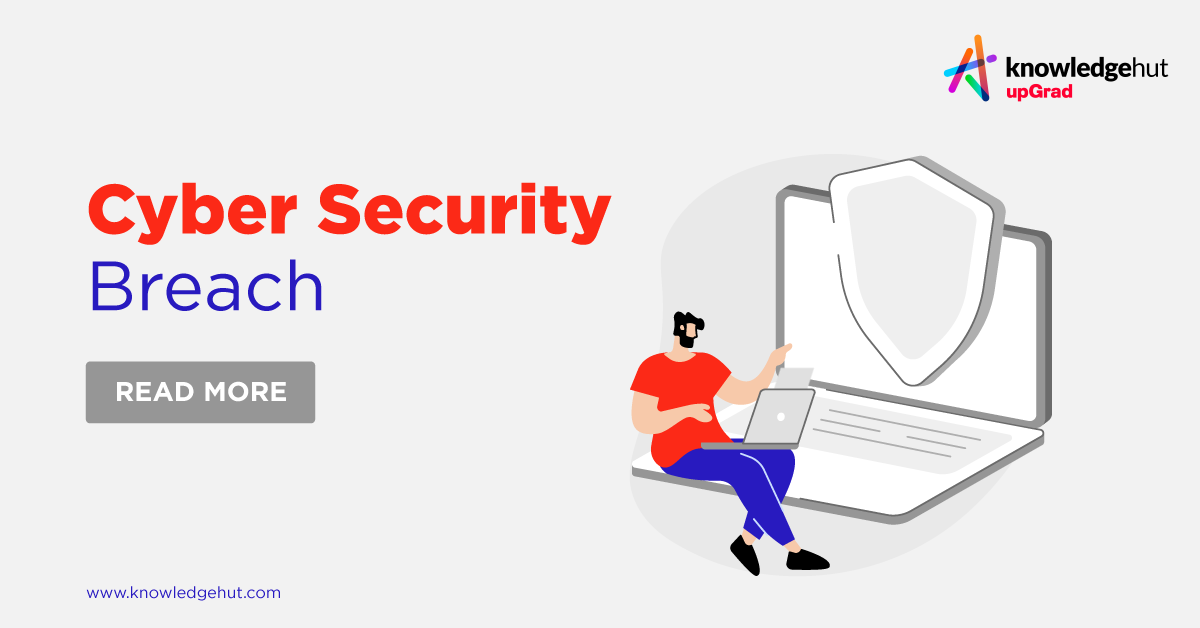Security breaches and data breaches are common nowadays, It does not matter how strong your company’s control is, the adversary somehow will find a way to get into your secured environment and compromise your security and data. Ideally, there is no blend of defenses that are 100% immune to action from a trained and determined attacker. The terrifying fact is that 60 percent of modest firms leave the business within six months of a security breach due to financial and reputational costs.
So, let’s talk more about these security and data breaches in this article to purely understand how these things are spreading and functioning in this digital ecosystem.
What is a Security Breach/Security Incident?
The term “security breach” is any condition, event, or situation that leads or results in any unauthorized access by an attacker to computer data, applications, networks, or devices. It results in data being accessed without authorization by an attacker. Commonly, it occurs when an intruder can circumvent security mechanisms.
Security breaches can be purposeful or accidental. Various motives for a deliberate security breach are as follows:
- to gain access to secure data,
- make use of resources like computing resources for their own grounds,
- and harm the network for personal intentions.
These cyber security attacks are very terrifying but it is easy to draft a plan for unexpected breaches that occur through some blend of error or negligence.
Is a Security Breach also a Data Breach?
There is a difference between a security breach and a data breach. The “what is a security breach” can be answered as, a“effectively a break-in”, on the other hand, “what is data breach” can be defined as an attacker getting away with your data, and if you also ask “what is a data leak” then it is the same as data breach. Visualizing a situation where a burglar climbs through the window is a security breach, and the data breach is when he enters your premises and steals your important things like a laptop and takes it away.
Confidential data has enormous value. It can be sold on the dark web like your names, debit cards, and credit card numbers can be bought, and then used for identity stealing or fraud. Security breach cost companies’ huge amounts of money and this is very shocking. On average, the bill is nearly $4m for major companies.
It’s also significant to differentiate the security breach definition from the definition of a security incident. An incident includes:
- Malware Infection
- A DDOS attack
- Or an employee leaving a laptop in a taxi
but if they don’t conclude access to the network or loss of data, it would not be considered a security breach.
When we talk about the in-depth difference about these two things then we need to gain detailed knowledge about cyber security which is more convenient to take a Cyber Security Classes Online which help you to gain information from scratch.
How Does a Data Breach Happen?
A data breach is a cyber security incident examples that results in sensitive data being exposed to an individual not authorized to access it.
It can be said that it is a result of an accidental event or deliberate action to steal information from an individual or organization. For example, an employee could accidentally uncover sensitive data, or they could intentionally steal company data and share it with a third party.
A data breach can be caused by an outside attacker, whose target is to obtain a specific type of data. An attacker also targets people within the organization. Hackers select specific individuals with targeted cybersecurity attacks.
Data breaches can be the consequence of a deliberate attack, an unintentional error or negligence by an employee, or an inherent loophole of an organization’s infrastructure. Following are some of the methods of the data breach:
- Insider Attack: An insider attack is a data breach. Under which employee leak data to a third party. This person will then steal data with the purpose of causing damage to the organization or individual within the company. Also known as a malicious insider. For example, the malicious insider can share the organization’s financial details or a client list with competitors. Alternatively, the malicious insider could access data about high-risk individuals within the company, even password details, and share them with a hacker for profit.
- Targeted Attack: Targeted data breach attacks include a cybercriminal or a group of attackers targeting particular individuals or companies to obtain confidential information. Attackers use various procedures to gain unauthorized access to corporate networks and systems.
- Phishing attack: When cybercriminals use social engineering to steal data like credit card details, login credentials, and user data is known as Phishing Attacks. Attacks typically disguise as an email or Short Message Service from a trusted person to dupe the victim into opening a malicious link.
- Malware attack: Under a malware attack, an attacker deceives a target into opening a malicious attachment, link, or website. The attacker will then inject malware onto the employee’s device to steal their credentials or other sensitive data from the servers.
- Vulnerability exploits: Under this, Cybercriminals continuously try to find out vulnerabilities in companies’ hardware or software that may exist in the company infrastructure due to the usage of outdated software or any kind of misconfiguration or even the attacker can target the organization by a zero-day attack where the attacker will exploit the vulnerability before becomes known to the company or a vendor.
- Loss or Theft: Loss of devices or unauthorized access to credentials, resulting in cybercriminals obtaining confidential data. These are all common types of security breach or incidents. For example, a lost laptop, mobile phone, or external hard drive that is unlocked can easily direct to data being stolen if it ends up in the wrong hands. Also, a locked device could be hacked into by a sophisticated attacker.
All these attacks are done by professional hackers and understanding them is important for any organization to protect them from outside and internal attacks. And the best way to learn about them is to Learn Ethical Hacking Online.
Types Of Data Breaches
In the past years, we’ve seen thousands of attacks that have breached the privacy of millions of people. From hacks that have affected college and their students and many more to breaches that have compromised data at hospitals, the list truly is limitless.
A data breach can also damage your brand and your revenue. Let’s take a glance at the most common types of data breaches and how they affect the business.
1. Hacking Intrusions
Hacking Intrusion contains a diversity of techniques used by cybercriminals or attackers to access and gain secure data, such as
- Phishing scams
- Brute force access attempts
- Ransomware,
and various forms of viruses/malware that cause the data breach or helped the attacker to do the data breach.
2. Insider Threat
One of the greatest security threats that companies face is employee error and intentional error that cause or create a reason to cause the data breach. To earn a profit, an employee uses his/her skill and knowledge of security controls to access and compromise data. It is shocking to hear that 90% of data breaches pertained to a human element. This involves incidents in which employees either disclose information directly or by creating an error that facilitates cyber criminals to access the organization’s systems.
3. Data on the Move
Laptop hard drives, backup tapes, and flash drives are all movable storage devices. They are convenient for bodily transferring data from one location to another but there is always a possibility of data being lost and if these devices get into the hands of bad guys, then they can retrieve the data and cause the breach or in some instances it is also possible that the adversary itself will try to steal those devices that carry data and that’s what we talk in next point which is physical theft.
4. Physical Theft
Most companies keep their IT networks secure behind firewalls and cybersecurity software. Which is necessary as well. But what if they must also face the situation where an employee leaves the organization with a laptop filled with proprietary and essential data? The threat attains access to a secure location and then downloads data and carries it into a movable drive. Therefore, organisation should protect their network.
5. Human Error
Unfortunately, negligence sometimes happens. It tends to happen quite often When it’s about cybersecurity and data handling. As per reports of ICO, roughly 90% of the country’s data breaches in 2019 were due to human error. As there is difference in human and in machine.
6. Accidental Internet Exposure
A number of companies believe that by disclosing data to the public at large that is on the internet the chances of risk or unauthorized access substantially increase.
Initially when information/data was kept or stored on-premises servers and gained access over LAN connections things were in control.
Cloud computing make sure that the organization should take proactive measures and protect data being accessed over the internet.
7. Unauthorized Access
Negligently monitored admin privileges, and an absence of user segmentation are examples of Ineffective access controls.
There are chances that companies may face security breaches in absence of access procedures. As a result, costly data breaches.
How to Avoid Data Breaches?
The following points that help in avoiding the data breach:
1. Identify All of Your organization’s IT Assets
If we don’t know what’s on the network then how do we protect our system? An Audit of IT assets needs to be conducted so to identify and protect all organisation IT assets. There is a need to protect and probably replicate as a portion of your recovery plan.
2. Add an Intrusion Detection System
For confirming an immediate response that reduces harm to do retrieval and risk mitigation easier it is crucial to spot a breach. When security breaches happen, it is detected by Intrusion detection systems so you can react to them as soon as possible.
It automatically triggers network breach response procedures. Which assists contain the attack immediately. Security information and event management systems both can help to obtain important information.
They provide important information about the network hacking attempt which discloses the policy of the attack. which helps in preventing future attacks.
3. Conduct Frequent Penetration Testing
Conduct Frequent Penetration tests are an important mechanism for risk reduction and point out vulnerabilities in your security preparations.
Under penetration tests, cybersecurity experts deliberately try to break your cybersecurity architecture. This enables you to understand how strong your controls are and also enables you to recognize potential deficiencies in the network and then fix them. After certain changes or modifications to your company’s software, a test should be conducted.
4. Create an Incident Response Team / Plan (IRT/IRP)
The incident response plan is very helpful. People with the right potential and experience to bear the response to a security breach are just significant. An incident response team can make sure your IRP is operating as smoothly as possible. Your IRT personnel will perform various activities like collecting, analysing, and acting on the selected data/information about security incidents.
IRP (Incident response plan) helps each employee of the organisation by informing them how they should react or respond in case of a data breach. According to IRP if an organisation wants that breach can be contained and eliminated rapidly an employee should react more quickly and consistently to network hacks.
The plan is distributed to every individual in the company under IRP, then examines what employees understood and whether they are able to fulfil the expectations.
Training sessions or conferences for explaining each content of the plan, and how to use specific tools. Therefore, every individual in an organisation has a role in IRP.
These types of data breaches and ways to prevent data breaches on the organizational level we cover them all in-depth and guide students at the industrial level. So, people who want to make their career in information security can join KnowledgeHut Learn Ethical Hacking online.
How to Check If You Had a Data Breach?
Most of the time whenever a data breach happens the personal information of the consumer gets leaked and sold off in the dark market. Usually, if things are present on the dark web, then normal people with good security knowledge can also access that data.
Some projects are on the internet which is working in the same direction and letting people know what kind of data is being leaked in the data breach earlier.
These project work in such a what that they always try to find all the data breaches that happened and data available on the dark web and then try to access the data and download it. After successful data download, they host that data on the normal inter so people can check if their data is being leaked in the history or not.
A good example of this work is one of the famous projects coming from the security researcher Troy Hunt name is haveibeenpwned and can be visited at website
https://haveibeenpwned.com/ (Screenshot attached below)
This website has data from 632 pwned websites, and 11,936,681,242 pwned accounts till the date this article published. Including data from Facebook, LinkedIn, Yatra, Twitter, etc.
Examples of Data Breaches
Here’s a glance at a few recent high-profile security breaches:
1. Facebook
It was very shocking that the personal data of over a billion Facebook users like their mobile numbers, dates of birth (DOB), locality info, email addresses, and more was leaked in the year 2021. This was possible with the help of a zero-day attack that let attackers obtain massive amounts of data from the organization’s servers.
2. Equifax
In the year 2017, the US credit bureau Equifax faces a security breach via a mediator software vulnerability. As per reports over 160 million people’s data was accessed by hackers. Therefore, making it one of the biggest identity theft cybercrimes to date.
Social Security numbers, birth dates, house addresses, and in some cases driver’s license numbers and credit card information are the data that was compromised.
Damages: As per reports around $700 million to support people affected by the data breach; reputational damage; congressional inquiries. which is very shocking.
3. Yahoo!
In yahoo’s case, as per reports almost 3 billion records were affected by security breaches, that’s a shocking number. User account names and passwords were put up for sale/deal on the dark web in the year 2016.
- The breach contains the Real names, email addresses, dates of birth, telephone numbers, and security questions that were compromised.
- Yahoo! accused the security breach of state-sponsored hackers, who were prepared to falsify cookie data to gain access to user accounts.
- Damages Around: As per report there was $350 million estimated loss in value of the organization.
4. EBay
In the year 2014, as per reports the US e-commerce huge eBay experienced a security breach that led to the wide-scale un-covering of personal account information or data.
5. Dominos
Recently in 2021, as per report data of 18 Crore users and their orders from Domino’s India have breached. And, interestingly Hacker created a search engine on Dark Web where user can search for their data if it was leaked (screenshots attached below).
6. Myspace data breach (2013)
As per reports affected Records was 360 million.
Email addresses, usernames, and passwords for some but not all affected accounts are the data that was compromised. Damages: leaked accounts could be hacked.
7. LinkedIn data breach (2012)
Records affected: As per reports165 million Usernames and passwords are the data which was compromised. Damages: paid approx. $1.25 million to breach victims in the U.S. who paid for premium services.
The Consequences of a Cyber Security Breach
Each company is unique in terms of the impact of a breach, depending on the timing and length of the industry in which it operates. For example, a data breach may have more pronounced results for the financial sector than, say, in manufacturing. However, common impacts you should consider when analysing your security posture include:
1. Reputational damage
Loss of consumer and contributors’ trust can be the most harmful result of cybercrime since the immense majority of people would not do work with an organization that had been breached, mainly if it proves unsuccessful to safeguard its customers data. This can result directly in a loss of business, as well as the weakening of the brand for which you’ve worked so hard. It is difficult to quantify the erosion of reputation due to a data breach on case-to-case basis.
2. Intellectual property theft
Small business defences are generally less advanced and simple to penetrate making them a fragile target while a cyber-raid on a big-name bank can let the attacker a sizable haul. Cyber fraud or crime can result in monetary losses. Looted information can be worth far more to hackers, particularly when sold on the Dark Web. As per reports, the normal price for commercially traded logins on the Deep web was a moderate $15.43. Intellectual property theft may be equally adverse, with organizations losing years of effort and R&D investment in trade secrets or copyrighted material and their competitive benefit.
3. Financial losses
Cybercrime fetch small businesses houses disproportionately added to huge businesses when adjusted for companies’ size. For a big corporation, the financial outcome of a breach may spread into the millions, but at their scale, the financial involvement is barely a clip on the tracking system. As per the latest data breach report, the average cost of a data breach in the year 2021 is $4.24M, a 10% increase from its average cost of $3.86M in the year 2019. Even more disturbing is the report’s finding that the longer a breach remains discreet, the higher its financial consequence.
4. Fines
As if straight financial losses weren’t penalizing sufficient, there is the prospect of monetary punishment for organizations that fail to conform with data protection legislation. In the year 2018, the General Data Protection Regulation run into effect in the EU. The enforcement powers associated with the law are significant. Fines for violations can attain up to 20 million Euros or 4% of a firm’s global annual revenue, per violation, whichever is larger.
How to Protect Yourself against a Data Breach?
No one is immune to a data breach; good system security habits can make you less vulnerable and can enable you to survive a breach with less disruption. This advice should
help you in preventing security breaches or data breaches.
- Use very strong passwords, which include haphazardly strings of upper and lower-case letters, numbers, and symbols. They are much more resilient to decode than simpler passwords. Family names or birthdays should not be used as a password as they are very simple to guess. Use a Password Manager to create your passwords secure.
- Use diversified passwords on different accounts: Having the same password for multiple accounts can be dangerous as if hackers obtained access to one account will be able to get into all your other accounts. If they have varied passwords, only that one account will be at harm.
- Shut down accounts you don’t use rather than leaving them dormant: That decreases your vulnerability to a security breach. If you don’t use an account, you might never understand that it has been compromised, and it could act as a back door to your other account.
- Change your passwords regularly: One feature of many publicly broadcasted security breaches is that they happened over a long period, and some were not reported until years after the breach. Regular password changes lessen the risk you run from unannounced data breaches.
- While accessing your accounts, be sure you’re using the secure HTTPS protocol and not just HTTP.
- Observing your bank statements and credit reports assists keep you safe. Stolen information can be sold on the deep web years after the original data breach. This could signal an identity theft effort happens long after you’ve forgotten the data breach that compromised that account.
- Value your personal information/data and don’t give it out unless necessary.
What to Do If You Experience a Data Breach?
If you are the victim of a security breach, act speedily to limit the damage. Change account passwords, in case your financial information is compromised instruct your bank immediately, and eliminate any personal information that may have leaked online.
Following are the steps you should take to recover from a cyberattack:
In Security breaches, generally, our online account names and passwords are being leaked. Changing passwords will restrict further damage.
In case your credit card data or your other financial information has been exposed, contact the bank instantly to prevent fraudulent activity.
If somebody managed to attain access to your computer you may have a malware infection. Use a best-trusted antivirus removal tool to recognize and remove any threats.
- Contact the relevant authorities
Connect to your local authorities if you are the victim of identity theft or fraud. This will help us to regain control over your accounts.
- Monitor your accounts and devices
In order to avoid suspicious activity, monitor your account and system closely.
How to recover from a Data Breach?
There are five phases of recovering from a security breach. what should a company do after a data breach ?
- Phase One – Stopping the Attack
The first step on the road to recovery is to point out that there was a breach. The quickly you spot a breach after it occurs, the better off your organization will be. As attackers may take some time to break out of the first system.
The second step involves cutting off the attacker’s access and isolating the system they’ve compromised.
The next point is to erase it. According to the type of data breach elimination may differ. For example, to get rid of ransomware all data storage media are completely formatted. Then, the destroyed information can be restored from a remote backup.
By performing all steps before the attacker attacks, one can lessen the destruction the breach causes.
After the source of the attack is eliminated, the recovery process starts.
- Phase Two: Investigating the Attack Method
It is important to prevent attackers from doing the exact same attack strategy again. This can be stopped by realizing how the attack happened. Every affected system should be examined so that if there are any indication of compromise the attacker have left on the system during the time in which they had access.
From the time of the breach activity logs should be secured at a later date for forensic analysis. This may help in identifying the origin of the security breach leak or attack and help in blocking the future attempts.
- Phase Three: Notifying Those Who May Have Been Affected
One should be able to define which systems were compromised and what type of data was put at threat during your examination of the breach. So that you can send out notifications to any party which may have been influenced by the security breach.
Notifications should be sent through multiple methods although the contact procedure may differ. So, ensure that those affected by a breach are notified. One can send regular emails or automated calls to warn consumers that they may have been affected and specify on what sorts of data the attacker has attack, and inform what steps to be taken safeguard themselves.
One should also inform the authorities as soon as possible so that they can assist with the investigation.
- Phase Four: Restoring Assets on Your Network
All the assets that were compromised in our network should be restored in several ways, relying on how we have prepared for the security breach. In some situations, it may be reasonable to just change the storage drives of the affected IT assets and download stolen data from a backup.
It should be reasonable to switch on entire cloud-based replicas of our network environment. So, to instantly restore your business network to normal while we work to examine the security breach.
How one can restore the assets on our network will rely on the business continuity and disaster recovery plan that you have. These should have been set well in advance to build fail-safes so that if one of our assets is taken down, we have ways of keeping your business going.
One has to be sure to catalog which assets have been taken down and what is presumed to be on our network. By this one can be sure that he/she hasn’t missed anything and that no extra surprises are left on their network.
- Phase Five: Preparing for the Future Attack
After following the BC/DR plan one has recovered from the attack. It is significant to prepare for the next attack. Chances are high of getting attacked again if we have been hit once by the same group or by others using the exact attack strategy.
The gaps in our cybersecurity can be recognized by studying the attack procedure and finding out how the attacker got in. As this will allow us to identify those gaps which lead to a breach and close them. Doing so can assist prevent future breaches.
All of these phases answers that how to deal with security breaches.
Data Breach – Best Practices
Few practices of data breach for enterprises and employee are as follows:
For Enterprises
Following are some data security best practices that help your company to keep valuable information safe.
- Catalog all enterprise data
Firstly, it is very significant to know what data or information exists in order to protect or secure it. Data/information flows all over and is secured under a distributed network of data centres, cloud servers, network-attached storage, mobile and remote users, desktops and applications. How the data is generated, used, stored, and destroyed security teams must realize this fact.
Developing and maintaining a broad data inventory is the first step. All data must be catalogued. The absence of the due diligence function confirms some data will be unprotected and vulnerable.
Cryptographic algorithms and confidential keys are used by encryption to ensure only authorized entities can read the data or information. It is used for data or information kept on a drive within an application.
If attackers gain encrypted data somehow, then also it is of no purpose as it cannot be coded. As a result, zero value is attained from the data. It is so helpful that regulations make it a secure harbour that limit liability following a data breach.
- Implement strong access controls
Important data must only be obtainable to those who need access to do their jobs. Building strong access control helps in identifying which entity should be able to access which data, and then supervising and regularly evaluating the entitlement of those organizations.
- Authorization and access controls may differ from passwords and audit logs to multifactor authentication, privileged access management, and necessary access controls. Doesn’t matter which procedure is used make sure to confirm the entity. On the basis of Principle of least privilege access should be granted. To quickly identify irregularities strong access controls is needed with full observing and auditing feature.
- Back-up data Integrity is as significant to security as confidentiality. A backup is a replica of the data that lives at several locations. It makes data retrieval realistic should the working copy become unavailable, deleted, or corrupted.
Backup should be performed at regular intervals. Make sure to keep backup safe as they can also be targeted.
For Employees
Employees are the backbone of each organization. They make sure that objectives are met and everything is moving smoothly. The weakest connection in the chain when it comes to an enterprise’s information security is humans. Employees who take cybersecurity directives lightly can impact an enterprise in several ways. By educating employees on information security best practices, enterprises can largely reduce this vulnerability. Following are the top cybersecurity best methods for employees to adopt so that their enterprise can stay safe and secure from cyber-attacks and data breaches.
- Learn to recognize & avoid phishing attacks
It is a social engineering strategy. Under this, an attacker sends an employee a fraudulent message via email, message, or text message, through a trusted source in the hope that the employee will click on the link that downloads malware onto their device, which will hold the system or divulge sensitive information of the companies.
If Employee receives any suspicious emails, links, or pop-ups, and open attachments, they should avoid them. Employees should be trained so that they can easily identify phishing attempts. Running phishing drive simulations can assist in testing an employee’s ability to prevent attacks and the effectiveness of an organization’s security training methods. A best practice is to prevent entering any personal or company information in response to an email, pop-up webpage, or any other kind of communication you didn’t commence.
- Use complex passwords and multi-factor authentication
Employee passwords should be complex and unique, i.e., made out of a mixture of upper- and lower-case alphabets, numbers, and symbols in order to ensure organization cyber security. If employees keep passwords that are easy to remember, the chances of it being figured out are extremely high, giving them access to the company’s significant infrastructure and sensitive information.
In addition to keeping a double check employees should use multi-factor authentication wherever possible. This adds a shield of protection by asking you to take at least one additional step such as giving a temporary code that is sent to your mobile to log in. Even if a password is detected, criminals will require access to an additional factor to gain access. There is various password management mechanism that employees can use to help stay secure.
- Utilizing secure wi-fi networks
Making sure that the office wi-fi network is secure and encrypted is a simple step to implement. With the rise in remote work arrangements, organizations require to provide their employees with the right tools & mechanisms to keep their information secure. Due to their open access and absence of vital security elements, public Wi-Fi networks have huge risks to information security.
Employees and their data can be protected by the company by making sure that employees utilize virtual private networks. VPNs enable hidden and unfindable online activity, greatly lessening the chances of anyone gaining access to your company’s systems or network.
- Practice data encryption and protection
When it comes to sharing or communicating sensitive information online, organizations are required to ensure that their employees do not divulge any sensitive data to the public and take extra safeguards. The way people avoid sharing their own personally notable information like their credit card details when answering emails, phone calls, or text messages. It is crucial to exercise the same vigilance in the workplace.
Hackers are creative in their procedures of deception and can pose as authoritative figures like government officials or upper management to trick employees into divulging sensitive data, such as login credentials. Therefore, employees need to take severe caution when communicating sensitive information, by making sure of the lawfulness of requests and encrypting data before sending it, so that the information can only be accessed by the receiver with the help of a decryption key.
Conclusion
Due to the increasing number of cybersecurity threats companies is under the pressure of being forced to react quickly. Companies are come up with a vulnerability management life cycle since the attackers have been using an attack life cycle. The vulnerability management life cycle is formulated to counter the attempts made by the attackers most effectively.
Due to the inherent nature of information technology, cybersecurity problems emerge. The complication of information technology systems, and human frailty in making decisions about what actions and information are safe or unsafe from a cybersecurity point of view, particularly when such actions and information are highly complex.
Cybersecurity is a never-ending topic or battle. A forever decisive solution to this problem will not be found in the foreseeable future. Cybersecurity threats evolve. As new defences occur to stop older threats, invaders adapt by developing new mechanisms and techniques to compromise security. As information technology merged into society, the motive to compromise the security of deployed IT systems grow.
As innovation makes fresh information technology applications, new places for criminals and other hostile parties along with new vulnerabilities that malicious actors can exploit. There are numbers of people with access to cyberspace increasing the number of the possible sufferer, and also the number of possible malevolent actors.
Frequently Asked Questions (FAQs)
1. What is the difference between an incident and a breach?
A security incident means a contravention of an organization’s security policy. On the other hand, a security breach is when an unauthorized or unapproved user obtains access to data, applications, networks, or devices which results in information/data being stolen or leaked.
Incidents and breaches go hand-in-hand, with most breaches happening after an incident.
2. What are the top 10 examples of security breaches?
Top 10 security breaches are as follows:
- First American Financial Corporation data breach (2019)
- Marriott International data breach (2018)
- Adult Friendfinders Networks data breach (2016)
- Facebook data breach (2019)
- Target data breach (2013)
- United state Office of Personnel Management data breach (2015)
- Myspace data breach (2013)
- LinkedIn data breach (2012)
- Equifax data breach (2017)
- Yahoo 3,000,000,000 records lost
3. How does a security breach end?
One cannot end the security breach. However, steps can be taken to prevent it. Following are the six solidly proven ways to prevent cyber security breaches from occurring at your company.
- Limit access to your most valuable data
- Third-party vendors must comply.
- Conduct employee training.
- Update software regularly
- Develop a cyber breach response plan.
- Difficult to decipher passwords
4. How common are security breaches?
As we all know security breaches are very common and very often occur. A cybercrime occurs every 39 seconds. The immense the data breach is, the less likely the company will have a further breach in the following two years.
5. Is data breach a cybercrime?
A: A data breach is an outcome of a cyberattack that enables cybercriminals to obtain unapproved access to a computer system or network and steals data of the consumers or users contained within.











/cdn.vox-cdn.com/uploads/chorus_asset/file/25679694/247327_Buying_Guide_Doorbells_CVirginia.jpg)






![What Does It Mean to Be AI Ready? [Infographic] What Does It Mean to Be AI Ready? [Infographic]](https://edsurge.imgix.net/uploads/post/image/16089/ES_GCPS_HERO-1731772617.png?auto=compress,format&w=1024&h=512&fit=crop)


Discussion about this post